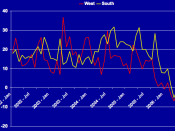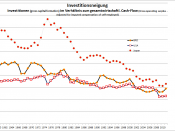Scenario
An asset is acquired at a cost of $10,000 with a five-year life and no anticipated salvage value. Straight-line depreciation is considered appropriate. The asset was acquired on January 2, 2000. Price indexes for the five years are:
2000 2001 2002 2003 2004
Fixed asset index 100 95 108 120 125
General price index 100 110 115 112 125
Compute the current value depreciation for each year.
* What is the realized real holding gain for the years 2001 - 2004?
* What would the holding gain be under EIP for the years 2001 - 2004?
Historical Cost Accounting
We will start with the depreciation according to historical cost accounting as a basis for the following calculations. The asset was purchased with a cost of $10,000 and a useful live of 5 years with no anticipated salvage value. We are also assuming straight-line depreciation which would result in a depreciation of $10,000 divided by 5 years equals $2,000 per year.
The results are shown in the following table.
Exhibit 1
General Price Level Adjustment
Costs are translated into current purchasing power dollars by adjusting values according to the general price index. Calculations are performed based on Wolk, Dodd, and Tearney (2004), p 467.
The factor that we use to adjust values - I will call it the General Price Index Factor or GPIF - is calculated by . Sample calculation for 2002: . This is the first step, see Exhibit 2.
Exhibit 2
Next we calculate the adjusted amounts for asset and depreciation by multiplying the historical amount by the GPIF, see Exhibit 3.
Exhibit 3
To calculate adjusted cash amounts we have to calculate a little differently since we need to adjust from year to year instead of from base year to current year. The GPIF relative to...


